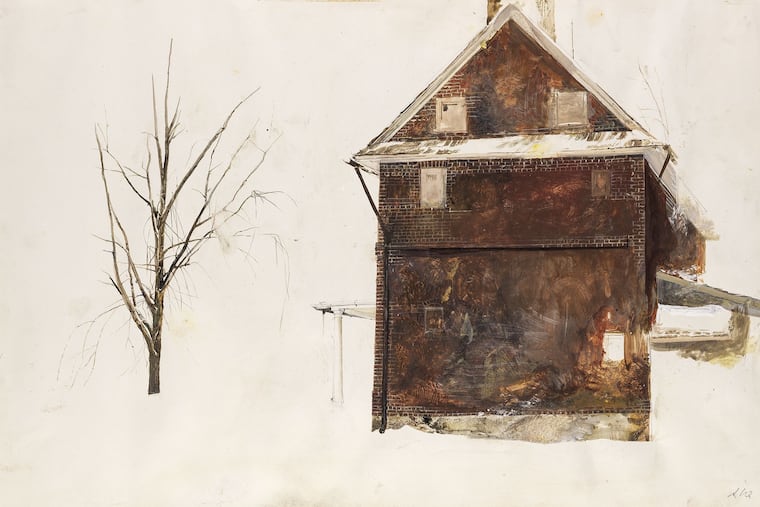Andrew Wyeth’s ‘Home Places,’ on exhibit at the Brandywine Museum of Art, includes many never-before-seen artworks
The exhibit is the first of many to come from a partnership between the Brandywine museum and the Wyeth Foundation struck last spring.

Christina’s World artist Andrew Wyeth drew inspiration from the simple buildings of his Chadds Ford hometown, finding new ways to paint them over the many years of his career. Nearly 50 of those creations are now on display at the Brandywine Museum of Art.
“Andrew Wyeth: Home Places” is the first exhibition to come out of the partnership between the Wyeth Foundation for American Art and the Brandywine museum. The Brandywine is managing the foundation’s Andrew and Betsy Wyeth Collection, which it shares with the Farnsworth Art Museum of Rockland, Maine. The “Home Places” exhibit, like the 7,000-piece Wyeth Foundation collection it is drawn from, features artworks that mostly have never been publicly displayed before. (His famous Christina’s World hangs in the Museum of Modern Art in New York.)
The new exhibit focuses on buildings that Wyeth repeatedly returned to artistically in the Chadds Ford area. Among them are the Barns-Brinton House, Painter’s Folly, and the Kuerner Farm.
In the words of the artist himself, from Andrew Wyeth: A Secret Life by Richard Meryman, “You can be in a place for years and years and not see something, and then when it dawns, all sorts of nuggets of richness start popping all over the place. You’ve gotten below the obvious.”
Included in the exhibit’s previously unseen works are The Miller’s Son, an oil painting Wyeth did when he was 17, and a watercolor called Noah’s Ark Study, which he made at age 87. Both are paintings of Brinton’s Mill, which Wyeth and his wife and collaborator, Betsy Wyeth, came to own and restore for use as their primary residence.
William L. Coleman, the museum’s inaugural Wyeth Foundation curator, said the huge collection that the current exhibit draws from ranges from some of Wyeth’s most recognizable and widely exhibited works to preliminary studies and drawings, which show the artist working out ideas.
“You get a sense of a creative mind at work,” said Coleman, who is also director of the Andrew and Betsy Wyeth Study Center. “We have this unique opportunity to give an insight into how these artworks, how these ideas came together.”
The exhibit explores “how this small group of historical houses spoke to him as this bottomless well of inspiration over a full artistic life centered on this radius of just about two square miles,” Coleman said. “He keeps coming back and back to these same old buildings, always finding something new in them, these layers of emotion, association, and abstraction.”
“Home Places” offers insight into how a small-but-rich geographic area continued to inspire one of America’s best-loved artists.
“It’s the story of an artist deeply rooted in place,” Coleman said.
With such a rich volume of Wyeth’s work to draw from, “Home Places” is just the first exhibition of many to come from the Brandywine Museum/Wyeth Collection Partnership.
One planned show will be Wyeth’s botanically-inspired work, the curator said. Another will be how Wyeth, famous for his realism, related to abstract art.
“We have some fascinating archival evidence that he was not threatened by new currents in contemporary art — a famous example, Jackson Pollack and his spatter painting,” said Coleman. “[Wyeth] was really curious about what was happening in the contemporary art world. He used abstraction when it served him. He used realistic painting when that’s what the subject called for.”
“Home Places” can be seen at the Brandywine Museum through July 16. brandywine.org/museum